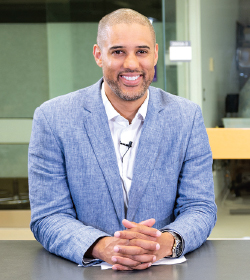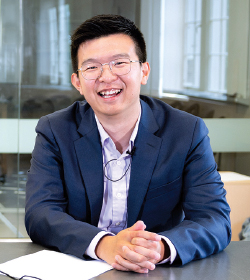The clinician-scientist: Driving knowledge and innovation in health care
MD/PhD candidate and Vanier Scholar Peter Zeng interviews his supervisor, Dr. Anthony Nichols, about the role of clinician scientists, mentorship and the future of cancer research care.
A conversation with Dr. Anthony Nichols
PETER ZENG: What character traits does a successful clinician-scientist need to have?
ANTHONY NICHOLS: There are several elements to becoming a clinician-scientist. It’s challenging; it’s hard to become clinically excellent and develop research excellence. So, how do you do both well? The first element is to get excellent training. You really want to get the best possible training from an elite mentor, but that mentor also has to give you sufficient time so that you can learn all the subtleties and nuances of being a successful clinician-scientist.
You also need ample resiliency. Everyone is going to face rejection. You have to be able to deal with the grant rejections and paper rejections and just keep on going and learn how to get better. It takes lots and lots of elbow grease, so to speak.
The delicate balance between the clinic and the lab also needs to be supported. Ideally, academic and hospital leaders will mandate protected time for individual clinician-scientists, will be there to support them financially and to support their research time in order for them to be successful.
PZ: How does mentorship play a role in your work as a clinician-scientist?
AN: Mentorship is absolutely critical. I’ve had many mentors along the way in every facet of research. One person particularly sticks out to me, Dr. James Rocco, a surgeon-scientist at Harvard University, where I did my residency training. He took me under his wing and showed me the ropes in the lab, translating patient samples, and even how to work with pharmaceutical companies to start clinical trials.
He also talked to me about the logistics and business side of being a clinicianscientist, in terms of looking for the right job, how to run a lab and the critical importance of getting grants.
 Dr. Anthony Nichols
Dr. Anthony Nichols
I have a hard time seeing how someone could be successful without a mentor like that in their career.
PZ: How can we better support underrepresented groups in science and medicine as clinician-scientists?
AN: It’s a really important aim. There’s been a great push towards more diversity in medicine.
In medical school, I was one of the founding members of the Black Medical Students Association at the University of Toronto. People of African descent are historically under-represented at every level of higher education, and the medical field is no exception to that. I think there’s a huge role for mentorship within under-represented communities, starting from the high school level up. I was very involved with that throughout medical school and currently I’m a mentor through the Black Physicians of Canada. I’d like to be more involved, and I really see that it’s something I’m going to invest a lot more time in through to the end of my career.
PZ: How can we encourage collaboration between basic scientists and clinicians?
AN: That’s an excellent question because the current state of science is that if you’re not first, you’re last. This creates an environment where researchers really want to hold on very dearly to their data and not share it.
Now there are big movements to make data publicly available and shareable. And there are a lot of collaborative networks that are really encouraging people to data share to surmount some of these challenges.
PZ: What is the Translational Head and Neck Cancer Research Program focused on?
AN: I have to give lots of credit to my colleagues, Dr. Kevin Fung and Joe Mymryk, PhD. We’ve developed this multifaceted research program, and it really breaks down to three things: biomarkers, novel therapies and clinical trials.
With almost every type of cancer, we want to start to personalize care. Right now, for many cancer types, patients come in and the treatment is one-sizefits- all; it’s a standard approach. But for some patients, that results in undertreatment and the disease will progress. For others, it results in over-treatment, and they’re left with life-long side effects. So, we’re in the process of generating additional biomarkers of outcomes to tailor therapy to each patient.
 Peter Zeng
Peter Zeng
We’re also trying to identify novel therapies in the cancer types that I deal with – thyroid cancer, as well as head, neck, and throat cancer – so that we can improve outcomes for the patients of tomorrow.
The last big focus for us is clinical trials. And all these three things mesh together.
PZ: What do you consider your biggest research accomplishment up to this point?
AN: Anyone looking at my work from the outside would say it’s probably the randomized trials I’ve led with Dr. David Palma comparing surgery and radiation treatment for certain head and neck tumours. But I would go bigger and say collaboration is my biggest accomplishment.
For example, our research group has successfully led, and continues to lead, some important international collaborations looking at thyroid cancer subtypes. This is work you’re also involved in, Peter, where we’re pooling data from multiple institutions to study human papillomavirus in connection to head and neck cancer.
In Canada, we’ve also developed a collaborative research initiative with novel, very practical clinical trials, as well as large retrospective studies.
And so really, I think it’s that legacy of collaboration and trying to bring people together. Although it’s cliche, together we all accomplish more. We’ve gotten a lot of mileage out of robust collaborations throughout Canada and across the world.
PZ: What do you think is the most exciting avenue for cancer research?
AN: Certainly, the last big breakthrough in cancer care is immunotherapy. Now that we’re starting to figure out ways that we can use the immune system to fight cancer, I see the difference in the clinic. Patients that would have been terminal or palliative even five years ago, we now have a variety of treatment options for. And we’ve started studying that in the lab.
The second thing is all the genomics technology that you’re using in your research project, Peter. Marrying that with immunotherapy to find the right treatment for the right patient, trying new immunotherapy combinations, I really think this is what’s going to make a big difference over the next 10 years.
Watch the full video interview at schulich/uwo.ca/rapport/2022/research








